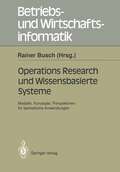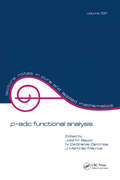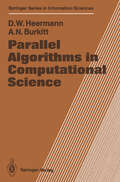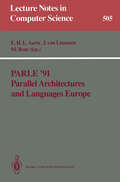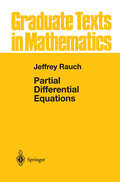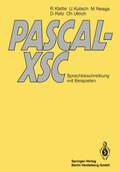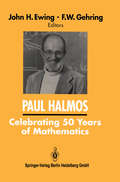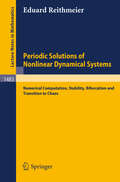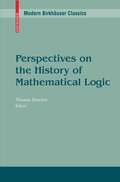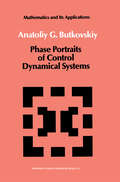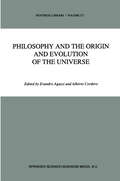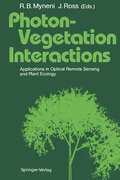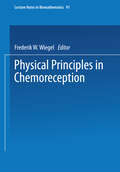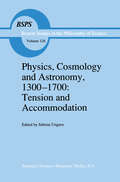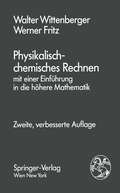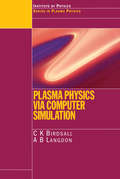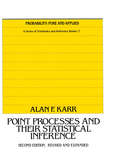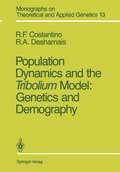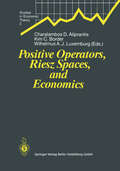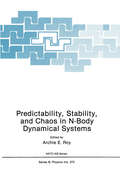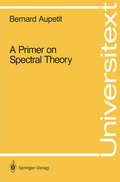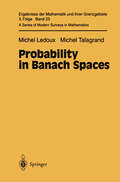- Table View
- List View
Operations Research und Wissenbasierte Systeme: Modelle, Konzepte, Perspektiven für betriebliche Anwendungen Ergebnisse der Arbeitsgruppe „Wirtschaftsinformatik“ der Deutschen Gesellschaft für Operations Research (DGOR) (Betriebs- und Wirtschaftsinformatik #49)
by Rainer BuschZiel der Deutschen Gesellschaft für Operations Research (DGOR) e.V. ist es, Operations Research (Unternehmensforschung) in Wirtschaft, Wissenschaft und in Verwaltung zu fördern und zu verbreiten. Dabei orientiert sie sich nicht nur an der im klassischen Sinne verstandenen Thematik, sondern befaßt sich auch mit den Themen, die im weiteren Sinne mit der Unter nehmensforschung verknüpft sind. Ausdruck dieser Orientierung sind zahl reiche Arbeitsgruppen mit entsprechender Themenstellung, so z.B. die Ar beitsgruppen "Personal Computing" und "Wirtschaftsinformatik". Mit den Arbeitsgruppen soll ein Forum angeboten werden, den Transfer von Wissen und Erfahrungen zwischen Theorie und Praxis zu fördern. Wirtschaftsinformatik als interdisziplinäres Fachgebiet zwischen Wirtschafts wissenschaften und Informatik (entsprechend der fortschreitenden Entwick lung der integrierten Fertigung (CIM) bestehen auch zunehmend interdiszi plinäre Überschneidungen mit den Ingenieurwissenschaften) befaßt sich mit dem Entwurf, der Entwicklung und dem Einsatz von Anwendungs- und Kommunikationssystemen in Wirtschaft und Verwaltung. Dabei sind die Prinzipien, Methoden, Modelle und Werkzeuge zu betrachten, die hierbei eingesetzt werden. Die Arbeitsgruppe "Wirtschaftsinformatik" nimmt hierzu aktuelle Themenstellungen auf, wobei sie -bedingt durch den heterogenen Teilnehmerkreis aus Banken, Handel, Industrie, Verwaltung und Wissen schaft - branchenspezifische Problemstellungen nur sekundär betrachtet. Theorie und Praxis sind in der thematischen Orientierung gleichgewichtig vertreten. Mit dem Rahmenthema "Operations Research und Wissensbasierte Systeme" sollte den Fragen nachgegangen werden, die sich aus den konkurrierenden Ansätzen der Modelle des Operations Research und Wissensbasierter Systeme ergeben, zumal festzustellen gilt, daß Wissensbasierte Systeme bzw. Experten systeme zunehmend für Anwendungsfelder entwickelt werden, zu denen bereits ausgereifte Operations-Research-Modelle mit effizienten Algorithmen existieren.
p-adic Function Analysis (Lecture Notes In Pure And Applied Mathematics Ser.)
by Jose M. Bayod"Written by accomplished and well-known researchers in the field, this unique volume discusses important research topics on p-adic functional analysis and closely related areas, provides an authoritative overview of the main investigative fronts where developments are expected in the future, and more. "
p-adic Function Analysis (Lecture Notes In Pure And Applied Mathematics Ser.)
by Jose M. Bayod"Written by accomplished and well-known researchers in the field, this unique volume discusses important research topics on p-adic functional analysis and closely related areas, provides an authoritative overview of the main investigative fronts where developments are expected in the future, and more. "
Parallel Algorithms in Computational Science (Springer Series in Information Sciences #24)
by Dieter W. Heermann Anthony N. BurkittOur aim in this book is to present and enlarge upon those aspects of parallel computing that are needed by practitioners of computational science. Today al most all classical sciences, such as mathematics, physics, chemistry and biology, employ numerical methods to help gain insight into nature. In addition to the traditional numerical methods, such as matrix inversions and the like, a whole new field of computational techniques has come to assume central importance, namely the numerical simulation methods. These methods are much less fully developed than those which are usually taught in a standard numerical math ematics course. However, they form a whole new set of tools for research in the physical sciences and are applicable to a very wide range of problems. At the same time there have been not only enormous strides forward in the speed and capability of computers but also dramatic new developments in computer architecture, and particularly in parallel computers. These improvements offer exciting prospects for computer studies of physical systems, and it is the new techniques and methods connected with such computer simulations that we seek to present in this book, particularly in the light of the possibilities opened up by parallel computers. It is clearly not possible at this early stage to write a definitive book on simulation methods and parallel computing.
Parle ’91 Parallel Architectures and Languages Europe: Volume I: Parallel Architectures and Algorithms Eindhoven, The Netherlands, June 10–13, 1991 Proceedings (Lecture Notes in Computer Science #505)
by Emile H. L. Aarts Jan Van Leeuwen Martin RemThe innovative progress in the development oflarge-and small-scale parallel computing systems and their increasing availability have caused a sharp rise in interest in the scientific principles that underlie parallel computation and parallel programming. The biannual "Parallel Architectures and Languages Europe" (PARLE) conferences aim at presenting current research material on all aspects of the theory, design, and application of parallel computing systems and parallel processing. At the same time, the goal of the PARLE conferences is to provide a forum for researchers and practitioners to ex change ideas on recent developments and trends in the field of parallel com puting and parallel programming. The first ~wo conferences, PARLE '87 and PARLE '89, have succeeded in meeting this goal and made PARLE a conference that is recognized worldwide in the field of parallel computation. PARLE '91 again offers a wealth of high-quality research material for the benefit of the scientific community. Compared to its predecessors, the scope of PARLE '91 has been broadened so as to cover the area of parallel algo rithms and complexity, in addition to the central themes of parallel archi tectures and languages. The proceedings of the PARLE '91 conference contain the text of all con tributed papers that were selected for the programme and of the invited papers by leading experts in the field.
Partial Differential Equations (Graduate Texts in Mathematics #128)
by Jeffrey RauchThis book is based on a course I have given five times at the University of Michigan, beginning in 1973. The aim is to present an introduction to a sampling of ideas, phenomena, and methods from the subject of partial differential equations that can be presented in one semester and requires no previous knowledge of differential equations. The problems, with hints and discussion, form an important and integral part of the course. In our department, students with a variety of specialties-notably differen tial geometry, numerical analysis, mathematical physics, complex analysis, physics, and partial differential equations-have a need for such a course. The goal of a one-term course forces the omission of many topics. Everyone, including me, can find fault with the selections that I have made. One of the things that makes partial differential equations difficult to learn is that it uses a wide variety of tools. In a short course, there is no time for the leisurely development of background material. Consequently, I suppose that the reader is trained in advanced calculus, real analysis, the rudiments of complex analysis, and the language offunctional analysis. Such a background is not unusual for the students mentioned above. Students missing one of the "essentials" can usually catch up simultaneously. A more difficult problem is what to do about the Theory of Distributions.
PASCAL-XSC: Sprachbeschreibung mit Beispielen
by Rudi Klatte Ulrich Kulisch Michael Neaga Dietmar Ratz Christian UllrichPASCAL-XSC (PASCAL-eXtension for Scientific Computation) ist eine Erweiterung der weitverbreiteten Programmiersprache PASCAL. Sie verfolgt das Ziel, das Programmieren, insbesondere im Bereich technisch-wissenschaftlicher Anwendungen, durch zusätzliche Sprachkonzepte wie Module, dynamische Felder und Operatoren erheblich zu vereinfachen. Eine optimale Arithmetik mit hochgenauen Standardfunktionen und exakter Ausdrucksauswertung ermöglicht eine automatisierte, zuverlässige Kontrolle der berechneten Ergebnisse. Damit unterstützt PASCAL-XSC die Entwicklung von Routinen mit automatischer Ergebnisverifikation. Mittels der Compiler-Implementierung in C kann PASCAL-XSC auf PC's, Workstations, Großrechnern und Supercomputern gleichermaßen eingesetzt werden. In dem vorliegenden Lehr- und Handbuch wird PASCAL-XSC vollständig beschrieben. Zur praktischen Verwendung und zum leichteren Kennenlernen und Vertrautwerden mit den über PASCAL hinausgehenden neuen Sprachelementen ist ein ausführlicher Abschnitt mit Übungsaufgaben und Lösungen aufgenommen worden. Ein kompletter Satz von Syntaxdiagrammen, sowie ausführliche Register und Verzeichnisse schließen dieses Buch ab.
PAUL HALMOS Celebrating 50 Years of Mathematics
by John. H. Ewing F. W. GehringPaul Halmos will celebrate his 75th birthday on the 3rd of March 1991. This volume, from colleagues, is an expression of affection for the man and respect for his contributions as scholar, writer, and teacher. It contains articles about Paul, about the times in which he worked and the places he has been, and about mathematics. Paul has furthered his profession in many ways and this collection reflects that diversity. Articles about Paul are not biographical, but rather tell about his ideas, his philosophy, and his style. Articles about the times and places in which Paul has worked describe people, events, and ways in which Paul has influenced students and colleagues over the past 50 years. Articles about mathematics are about all kinds of mathematics, including operator theory and Paul's research in the subject. This volume represents a slice of mathematical life and it shows how many parts of mathematics Paul has touched. It is fitting that this volume has been produced with the support and cooperation of Springer-Verlag. For over 35 years, Paul has contributed to mathematics publishing as founder and editor of many outstanding series.
Periodic Solutions of Nonlinear Dynamical Systems: Numerical Computation, Stability, Bifurcation and Transition to Chaos (Lecture Notes in Mathematics #1483)
by Eduard ReithmeierLimit cycles or, more general, periodic solutions of nonlinear dynamical systems occur in many different fields of application. Although, there is extensive literature on periodic solutions, in particular on existence theorems, the connection to physical and technical applications needs to be improved. The bifurcation behavior of periodic solutions by means of parameter variations plays an important role in transition to chaos, so numerical algorithms are necessary to compute periodic solutions and investigate their stability on a numerical basis. From the technical point of view, dynamical systems with discontinuities are of special interest. The discontinuities may occur with respect to the variables describing the configuration space manifold or/and with respect to the variables of the vector-field of the dynamical system. The multiple shooting method is employed in computing limit cycles numerically, and is modified for systems with discontinuities. The theory is supported by numerous examples, mainly from the field of nonlinear vibrations. The text addresses mathematicians interested in engineering problems as well as engineers working with nonlinear dynamics.
Perspectives on the History of Mathematical Logic (Modern Birkhäuser Classics)
by Thomas DruckerThis volume offers insights into the development of mathematical logic over the last century. Arising from a special session of the history of logic at an American Mathematical Society meeting, the chapters explore technical innovations, the philosophical consequences of work during the period, and the historical and social context in which the logicians worked. The discussions herein will appeal to mathematical logicians and historians of mathematics, as well as philosophers and historians of science.
Phase Portraits of Control Dynamical Systems (Mathematics and its Applications #63)
by A.G. ButkovskiyPhilosophy and the Origin and Evolution of the Universe (Synthese Library #217)
by E. Agazzi A. CorderoIt has often been noted that a kind of double dynamics char- terizes the development of science. On the one hand the progress in every discipline appears as the consequence of an increasing specialization, implying the restriction of the inquiry to very partial fields or aspects of a given domain. On the other hand, an opposite (but one might better say a complementary) trend points towards the construction of theoretical frameworks of great ge- rality, the aim of which seems to correspond not so much to the need of providing «explanations» for the details accumulated through partial investigation, as to the desire of attaining an - rizon of global comprehension of the whole field. This intell- tual dialectics is perceivable in every discipline, from mathe- tics, to physics, to biology, to history, to economics, to sociology, and it is not difficult to recognize there the presence of the two main attitudes according to which human beings try to make «intelligible» the world surrounding them (including themselves), attitudes which are sometimes called analysis and synthesis. They correspond respectively to the spontaneous inclination which pushes us to try to understand things by seeing «how they are made», in the sense of «looking into them» and breaking them into their constitutive parts, or rather to encompass things in a global picture, where they are accounted for as occupying a place, or playing a role, which are understandable from the point of view of the whole.
Photon-Vegetation Interactions: Applications in Optical Remote Sensing and Plant Ecology
by Ranga B. Myneni Juhan RossPhoton-Vegetation Interactions deals with the interaction of electromagnetic radiation with vegetation canopies. The approach to the various aspects is mainly theoretical and consequently the subject is being treated as a special branch of mathematical physics. A major emphasis is on the development of theoretical methods for determining the reflection function of vegetation canopies in optical remote sensing. Furthermore, the coupling of the radiative transfer theory with leaf photosynthesis to evaluate the productivity of vegetation canopies is treated as well as the theory of photon transport in phototropic and other biological media.
Physical Principles in Chemoreception (Lecture Notes in Biomathematics #91)
by Frederik W. WiegelIs it not sheer foolishness to try to apply the methods of theoretical physics to biological structures? Physics flowered because it limited itself to the study of very simple systems; on the other hand, the essence of "living things" seems to have to do with the extreme intricacy of their structure. Is it a hopeless endeavour to attempt to bring the two together, or should one try nevertheless? Most of my colleagues in theoretical physics feel one should not waste one's time and stick to "the good old hydrogen atom", but some of them feel one should try anyhow. This minority point of view was shared by Bohr in the thirties, Schrödinger in the fourties, Delbrück in the fifties and sixties, PurceIl in the seventies, etc. The theory of chemoreception represents only a very small part of this immense scientific question. Its study was started by Delbriick and others in the fifties. I was introduced to these problems by Charles DeLisi, during a visit to the National Institutes of Health in the summer of 1980. During the following decade I had the pleasure to collaborate with George Bell, Byron Goldstein, Alan Perelson and others at the Los Alamos National Laboratory. We studied a wide variety of questions, some of them relevant to the theory of chemoreception. I am grateful to them, both for the pleasure which our joint research always gives to me, as weIl as for their friendship and hospitality.
Physics, Cosmology and Astronomy, 1300–1700: Tension and Accommodation (Boston Studies in the Philosophy and History of Science #126)
by SabetaiUnguruHabent sua Jata colloquia. The present volume has its ongms in a spring 1984 international workshop held, under the auspices of the Israel Academy of Sciences and Humanities, by The Institute for the History and Philosophy of Science and Ideas of Tel-Aviv University in cooperation with The Van Leer Jerusalem Foundation. It contains twelve of the twenty papers presented at the workshop by the twenty-six participants. As Proceedings of conferences go, it is a good representative of the genre, sharing in the main characteristics of its ilk. It may even be one of the rare instances of a book of Proceed ings whose descriptive title applies equally well to the workshop's topic and to the interrelations between. the various papers it includes. Tension and Accommodation are the key words. Thus, while John Glucker's paper, 'Images of Plato in Late Antiqu ity,' raises, by means of the Platonic example, the problem of interpreta tion of ancient texts, suggesting the assignment of proper weight to the creator of the tradition and not only to his many later interpreters in assessing the proper relationship between originator and commentators, Abraham Wasserstein's 'Hunches that did not come off: Some Prob lems in Greek Science' illustrates the long-lived Whiggish tradition in the history of science and mathematics. As those familiar with my work will undoubtedly note, Wasserstein's position is far removed from my stance on ancient Greek mathematics.
Physikalisch-chemisches Rechnen: mit einer Einführung in die höhere Mathematik
by Walter Wittenberger Werner FritzPlasma Physics via Computer Simulation (Series in Plasma Physics)
by C.K. Birdsall A.B LangdonDivided into three main parts, the book guides the reader to an understanding of the basic concepts in this fascinating field of research. Part 1 introduces you to the fundamental concepts of simulation. It examines one-dimensional electrostatic codes and electromagnetic codes, and describes the numerical methods and analysis. Part 2 explores the mathematics and physics behind the algorithms used in Part 1. In Part 3, the authors address some of the more complicated simulations in two and three dimensions. The book introduces projects to encourage practical work Readers can download plasma modeling and simulation software — the ES1 program — with implementations for PCs and Unix systems along with the original FORTRAN source code. Now available in paperback, Plasma Physics via Computer Simulation is an ideal complement to plasma physics courses and for self-study.
Plasma Physics via Computer Simulation (Series in Plasma Physics)
by C.K. Birdsall A.B LangdonDivided into three main parts, the book guides the reader to an understanding of the basic concepts in this fascinating field of research. Part 1 introduces you to the fundamental concepts of simulation. It examines one-dimensional electrostatic codes and electromagnetic codes, and describes the numerical methods and analysis. Part 2 explores the mathematics and physics behind the algorithms used in Part 1. In Part 3, the authors address some of the more complicated simulations in two and three dimensions. The book introduces projects to encourage practical work Readers can download plasma modeling and simulation software — the ES1 program — with implementations for PCs and Unix systems along with the original FORTRAN source code. Now available in paperback, Plasma Physics via Computer Simulation is an ideal complement to plasma physics courses and for self-study.
Point Processes and Their Statistical Inference
by Alan KarrFirst Published in 2017. Routledge is an imprint of Taylor & Francis, an Informa company.
Point Processes and Their Statistical Inference (Probability Ser. #No. 2)
by Alan KarrFirst Published in 2017. Routledge is an imprint of Taylor & Francis, an Informa company.
Population Dynamics and the Tribolium Model: Genetics and Demography (Monographs on Theoretical and Applied Genetics #13)
by Robert F. Costantino Robert A. DesharnaisThe study of populations is becoming increasingly focused on dynamics. We believe there are two reasons for this trend. The ftrst is the impactof nonlinear dynamics with its exciting ideas and colorful language: bifurcations, domains of attraction, chaos, fractals, strange attractors. Complexity, which is so very much a part of biology, now seems to be also a part of mathematics. A second trend is the accessibility of the new concepts. Thebarriers tocommunicationbetween theoristandexperimentalistseemless impenetrable. The active participationofthe experimentalist means that the theory will obtain substance. Our role is the application of the theory of dynamics to the analysis ofbiological populations. We began our work early in 1979 by writing an ordinary differential equation for the rateofchange in adult numbers which was based on an equilibrium model proposed adecadeearlier. Duringthenextfewmonths weftlledournotebookswithstraightforward deductions from the model and its associated biological implications. Slowly, some of the biological observations were explained and papers followed on a variety of topics: genetic and demographic stability, stationary probability distributions for population size,population growth asabirth-deathprocess, natural selectionanddensity-dependent population growth, genetic disequilibrium, and the stationary stochastic dynamics of adult numbers.
Positive Operators, Riesz Spaces, and Economics: Proceedings of a Conference at Caltech, Pasadena, California, April 16–20, 1990 (Studies in Economic Theory #2)
by Charalambos D. Aliprantis Kim C. Border Wilhelmus A. J. LuxemburgOver the last fifty years advanced mathematical tools have become an integral part in the development of modern economic theory. Economists continue to invoke sophisticated mathematical techniques and ideas in order to understand complex economic and social problems. In the last ten years the theory of Riesz spaces (vector lattices) has been successfully applied to economic theory. By now it is understood relatively well that the lattice structure of Riesz spaces can be employed to capture and interpret several economic notions. On April 16-20, 1990, a small conference on Riesz Spaces, Positive Opera tors, and their Applications to Economics took place at the California Institute of Technology. The purpose of the conference was to bring mathematicians special ized in Riesz Spaces and economists specialized in General Equilibrium together to exchange ideas and advance the interdisciplinary cooperation between math ematicians and economists. This volume is a collection of papers that represent the talks and discussions of the participants at the week-long conference. We take this opportunity to thank all the participants of the conference, especially those whose articles are contained in this volume. We also greatly ap preciate the financial support provided by the California Institute of Technology. In particular, we express our sincerest thanks to David Grether, John Ledyard, and David Wales for their support. Finally, we would like to thank Susan Davis, Victoria Mason, and Marge D'Elia who handled the delicate logistics for the smooth running of the confer ence.
Predictability, Stability, and Chaos in N-Body Dynamical Systems (Nato Science Series B: #272)
by Archie E. RoyThe reader will find in this volume the Proceedings of the NATO Advanced Study Institute held in Cortina d'Ampezzo, Italy between August 6 and August 17, 1990 under the title "Predictability, Stability, and Chaos in N-Body Dynamical Systems". The Institute was the latest in a series held at three-yearly inter vals from 1972 to 1987 in dynamical astronomy, theoretical mechanics and celestial mechanics. These previous institutes, held in high esteem by the international community of research workers, have resulted in a series of well-received Proceedings. The 1990 Institute attracted 74 participants from 16 countries, six outside the NATO group. Fifteen series of lectures were given by invited speakers; additionally some 40 valuable presentations were made by the younger participants, most of which are included in these Proceedings. The last twenty years in particular has been a time of increasingly rapid progress in tackling long-standing and also newly-arising problems in dynamics of N-body systems, point-mass and non-point-mass, a rate of progress achieved because of correspondingly rapid developments of new computer hardware and software together with the advent of new analytical techniques. It was a time of exciting progress culminating in the ability to carry out research programmes into the evolution of the outer Solar 8 System over periods of more than 10 years and to study star cluster and galactic models in unprecedented detail.
Probability in Banach Spaces: Isoperimetry and Processes (Classics In Mathematics Ser.)
by Michel Ledoux Michel TalagrandIsoperimetric, measure concentration and random process techniques appear at the basis of the modern understanding of Probability in Banach spaces. Based on these tools, the book presents a complete treatment of the main aspects of Probability in Banach spaces (integrability and limit theorems for vector valued random variables, boundedness and continuity of random processes) and of some of their links to Geometry of Banach spaces (via the type and cotype properties). Its purpose is to present some of the main aspects of this theory, from the foundations to the most important achievements. The main features of the investigation are the systematic use of isoperimetry and concentration of measure and abstract random process techniques (entropy and majorizing measures). Examples of these probabilistic tools and ideas to classical Banach space theory are further developed.
